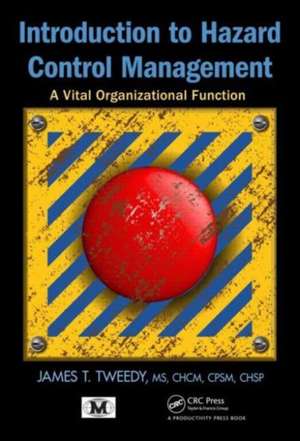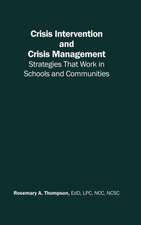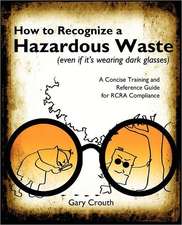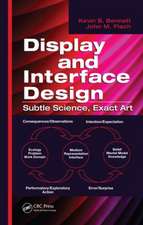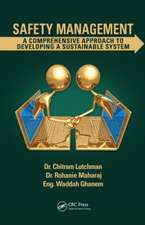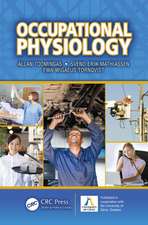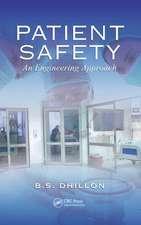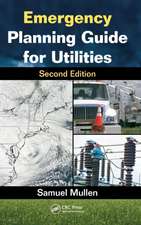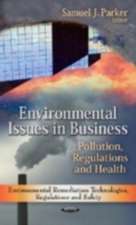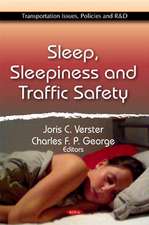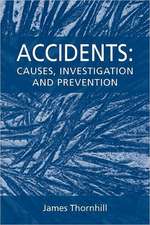Introduction to Hazard Control Management: A Vital Organizational Function
Autor James T. Tweedyen Limba Engleză Hardback – 24 sep 2013
Preț: 790.34 lei
Preț vechi: 963.83 lei
-18% Nou
Puncte Express: 1186
Preț estimativ în valută:
151.22€ • 157.91$ • 124.88£
151.22€ • 157.91$ • 124.88£
Carte tipărită la comandă
Livrare economică 15-29 aprilie
Preluare comenzi: 021 569.72.76
Specificații
ISBN-13: 9781466551589
ISBN-10: 1466551585
Pagini: 288
Ilustrații: 3 b/w images and 86 tables
Dimensiuni: 175 x 254 x 20 mm
Greutate: 0.68 kg
Ediția:New.
Editura: Routledge
ISBN-10: 1466551585
Pagini: 288
Ilustrații: 3 b/w images and 86 tables
Dimensiuni: 175 x 254 x 20 mm
Greutate: 0.68 kg
Ediția:New.
Editura: Routledge
Public țintă
James T. Tweedy is the Executive Director of the International Board for Certification of Safety Managers.Cuprins
Hazard Control Concepts and Principles
Hazard Control Management
Program or Function
Hazard Control Is Good Business
Hazard Control Responsibilities
Hazard Control Manager Responsibilities
Supervisor Responsibilities
Addressing Behaviors
Employee Engagement
Working with Employee Organizations
Hazard Control Practice
Hazard Control Policy Statements
Hazard Control Plan
Objectives and Goals
Reviewing Plans, Policies, and Procedures
Hazards
Hazard Identification
Managing Hazards
Preparing for Inspections
Inspection Reports
Hazard Analysis
Change Analysis
Creative Hazard Analysis
Risk Analysis
Phase Hazard Analysis
Process Hazard Analysis
Job Hazard Analysis
Job Design
Hazard Control and Correction
Engineering Controls
Administrative Controls
Work Practices Controls
Warnings, Signs, and Labels
Personal Protective Equipment
Eye and Face Protection
Head Protection
Foot Protection
Arm and Hand Protection
Body and Torso Protection
Hazard Control Committees and Teams
Hazard Survey Teams
Evaluation of Hazard Control Function Effectiveness
Areas to Evaluate
Review Exercises
Leadership and Management
Leadership
Practical Leadership
Ethics and Leadership
Management
Management Theories
Peter Drucker
Classic Management Theory
Motivation-Hygiene Theory
Managerial Grid
Theory S
Theory Z
Learning Organizations and Managing Knowledge
Decision Making
Management by Exception
Functions of Management
Planning
Directing
Organizing
Controlling
Coordinating
Staffing
Improvement Management
LEAN
SIX SIGMA and Safety
Project Management
Psychological Safety
Crisis Management
Organizational Dynamics
Traditional Organizational Structure
Organizational Culture
Covert and Overt Cultures
The Grapevine
Culture Socialization
Culture Change
Effective Speaking and Writing
Communication
Communication Barriers
Effective Writing
Purpose for Writing
Persuasive Writing
Editing
Writing a Report
Review Exercises
Understanding Accidents
Accident Causation Theories
Henri Heinrich’s Five-Factor Accident Sequence
Multiple-Causation Theory
Biased-Liability Theory
Accident Pyramid
Prevention of Fatal Events
Human Factors
Error
Motivating People
Accident-Deviation Models
Accident Reporting
Accident Investigations
Classifying Causal Factors
Interviewing Witnesses
Accident Analysis
Root-Cause Analysis (RCA)
Accident Reports
Organizational Functions That Support Accident Prevention
Interfacing Support Functions
Operational and Support Functions
Human Resources
Facility Management
Purchasing/Receiving
Employee Health
Shift Workers
Worker Compensation
Return-to-Work/Modified-Duty Positions
Substance Abuse
Orientation, Education, and Training
Providing Adequate Sessions
Training and Hazard Control
Training Methods
Off-the-Job Safety Education
Instructional System Design (ISD)
Promoting Hazard Control
Review Exercises
Hazard Control—Related Disciplines
Common Facility Hazards
Preventing Slips, Trips, and Falls
Electrical Safety
Noise Hazards
Heating, Ventilation, and Air Conditioning (HVAC) Systems
Indoor Air Quality
General Machine and Tool Safety
Powered Industrial Trucks (29 CFR 1910.178)
Ladder and Scaffold Safety
Control of Hazardous Energy (29 CFR 1910.147)
Permit Confined Spaces (29 CFR 1910.146)
System Safety and Engineering
System-Related Discovery Tools
Industrial Hygiene
Ergonomics and Human Factors
Robotic Safety
Environmental Management
Product Safety
Hazard Analysis Control Critical Point
Laboratory Safety
Infection Control
Private and Industrial Security
Fleet and Vehicle Safety
Safe Practices for Motor Vehicle Operations (ANSI/ASSE Z15.1 Standard)
Review Exercises
Government, Consensus, and Voluntary Organizations
Federal Register
Code of Federal Regulations
Occupational Safety and Health Administration (OSHA)
Occupational Safety and Health Review Commission
Environmental Protection Agency
Department of Transportation
Mine Safety and Health Administration
Nuclear Regulatory Commission
Department of Health and Human Services
Department of Homeland Security
National Transportation Safety Board
Chemical Safety Board
Consumer Product Safety Commission
Consensus Standards Organizations
American Conference of Governmental Industrial Hygienists
American National Standards Institute
American Society of Heating, Refrigerating, and Air-Conditioning Engineers
American Society of Testing Materials International
Compressed Gas Association
Factory Mutual Research Corporation
International Electrotechnical Commission
National Council on Radiation Protection and Measurements
National Fire Protection Association
National Sanitation Foundation International
Safety Equipment Institute
Underwriters Laboratories
National Board of Boiler and Pressure Vessel Inspectors
Professional Society and Membership Associations
Society for Human Resource Management
American Association of Occupational Health Nurses
Association of Occupational Health Professionals
American Chemistry Council
American Health Care Association
American Hospital Association
American Industrial Hygiene Association
American Osteopathic Association
American Public Health Association
American Society of Healthcare Engineering
American Society of Industrial Security
American Society of Safety Engineers
American Welding Society
CHEMTREC
ECRI Institute
Ergonomics Society
Health Physics Society
Human Factors and Ergonomics Society
International Association of Nanotechnology
International Consumer Product Health and Safety Organization
International Organization for Standardization
International System Safety Society
National Restaurant Association National Safety Council
Risk and Insurance Management Society
Review Exercises
Managing Hazardous Materials
Definitions
Respiratory Protection (29 CFR 1910.134)
Types of Respirators
Determining Cartridge Type and Selecting Respirators
Medical Evaluations
Fit Testing
Training and Information
Program Evaluation
Recordkeeping Requirements
Physical Properties of Hazardous Materials
Airborne Exposure
OSHA Additive Formula
Emergency Showers and Eyewashes
Chemical Storage Considerations
Compressed Gas Safety
OSHA Hazard Communication Standard (29 CFR 1910.1200)
Globally Harmonized System
Major Hazard Communication Standard Changes
Label Changes in the Revised Hazard Communication Standard
Safety Data Sheet Changes
Addressing Pyrophoric Gases, Simple Asphyxiant, and Combustible Dust
Managing and Communicating Changes to the Hazard Communication
Standard
Employee Training
Aspects of Pesticide Regulation That GHS Does Not Affect
Piping Systems Identification (ANSI Z13.1)
DOT Hazardous Material Regulations
Placards
Containers
Common Workplace Chemical Hazards
Managing Waste
Other Types of Hazardous Waste
Universal Waste
Medical Waste
Electronic Waste (E-Waste)
Hazardous Waste Operations and Emergency Response Standard
Chemical Protective Clothing
Process Safety Management
Ionizing Radiation
Nuclear Regulatory Commission
Ionizing Exposures
Agreement State Program
Units of Measure
National Council on Radiation Protection
Food and Drug Administration
OSHA Ionizing Radiation Standard (29 CFR 1910.1096)
Radioactive Waste Management
OSHA Nonionizing Radiation Standard (29 CFR 1910.97)
Standards for RF Exposures and Measurements
Ultraviolet Radiation
Visible and Infrared
Laser Standards
ANSI Z-136.1, Safe Use of Lasers
ANSI Z-136.3, Safe Use of Lasers in Health Care
ANSI Z136.4, Recommended Practice for Laser Safety Measurements
ANSI Z136.5, Safe Use of Lasers in Educational Institutions
ANSI Z136.6, Safe Use of Lasers Outdoors
ANSI Z136.7, Testing and Labeling of Laser Protective Equipment
ANSI Z136.8, Safe Use of Lasers in Research, Development, or Testing
Laser Hazard Classification
Class 1 Lasers
Class 2 Lasers
Class 1M Lasers
Class 2M Lasers
Class 3R Lasers
Class 3B Lasers
Class 4 Lasers
Laser Safety Officers
Nanotechnology
NIOSH Research
Review Exercises
Fire Safety and Emergency Management
Life Safety Code, National Fire Protection Association 101
Understanding Fire
Deficiencies
Fire Safety Evaluation System
Design Considerations
Fire Prevention
General Alarm Requirements
Fire System Inspections
Fire Confinement
Emergency Exits
Emergency Lighting
OSHA Egress and Exit Standards
Portable Fire Extinguishers (29CFR 1910.157)
Maintenance
Portable Fire Extinguishers
Marking Extinguishers
Flammable and Combustible Materials
Fire and Chemical Hazard Symbols
Electrical Equipment Installations
OSHA Emergency Action Requirements
Emergency Management
Organizational Emergency Medical Care and First Aid
Dealing with Risk
Disaster Management and Business Continuity
Emergency Management Planning
Incident Command System
Operations and Planning
Logistics
Finance or Administration
Communication and Information Management
Common Incident Command System Principles and Terms
Standardization
Community Involvement
Health-Care Facilities
Weather-Related Emergencies
Tropical Storms and Hurricanes
Thunderstorms
Floods
Tornadoes
Winter Storms
Wildfires
Earthquakes
Technology Emergencies
Transportation Accidents
Bomb Threats
Information and Communication Emergencies
Telecommunications Service Priority Program
Government Emergency Telecommunications Service Program
Wireless Priority Service
Cyber Attack Incident Response
Homeland Security Exercise and Evaluation Program
Planning for Terrorism
Biological Agents
Bacteria, Viruses, and Toxins
Chemical Agents
Blood Agents
Blister Agents (Vesicants)
Choking Agents
Irritating Agents
Nerve Agents
Industrial Chemical Agents
Nuclear Devices
Nuclear Incident Response Team of Department of Energy
National Nuclear Security Administration
National Institute of Occupational Safety and Health Publication
Number 2002-139
National Disaster Medical System
Pandemic Planning
Review Exercises
Appendices:
Hazard Control Management Evaluation Scoring System
Hazard Control Perception Survey
Sample Hazard Correction Form
Sample Hazard Control Status Report
Hazard Control Improvement Principles
Accident Causal Factors Chart
Sample Ergonomic Symptom Report
Hazardous Material Exposure Limits and Terms
Hazardous Material Ratings
Small-Facility HAZCOM Training Record
Small-Facility Model Hazard Communication Plan
NFPA Codes and Standards Listing
Occupational Safety and Health Administration Personal Protective Equipment Hazard Assessment Form
Sample Initial Accident Investigation Form
Small-Facility Model Respirator Plan
Sample Workplace Violence Prevention Policy
Hazard ControlߝRelated Acronyms
Hazard Control Glossary of Terms
Suggested Reading
Index
Hazard Control Management
Program or Function
Hazard Control Is Good Business
Hazard Control Responsibilities
Hazard Control Manager Responsibilities
Supervisor Responsibilities
Addressing Behaviors
Employee Engagement
Working with Employee Organizations
Hazard Control Practice
Hazard Control Policy Statements
Hazard Control Plan
Objectives and Goals
Reviewing Plans, Policies, and Procedures
Hazards
Hazard Identification
Managing Hazards
Preparing for Inspections
Inspection Reports
Hazard Analysis
Change Analysis
Creative Hazard Analysis
Risk Analysis
Phase Hazard Analysis
Process Hazard Analysis
Job Hazard Analysis
Job Design
Hazard Control and Correction
Engineering Controls
Administrative Controls
Work Practices Controls
Warnings, Signs, and Labels
Personal Protective Equipment
Eye and Face Protection
Head Protection
Foot Protection
Arm and Hand Protection
Body and Torso Protection
Hazard Control Committees and Teams
Hazard Survey Teams
Evaluation of Hazard Control Function Effectiveness
Areas to Evaluate
Review Exercises
Leadership and Management
Leadership
Practical Leadership
Ethics and Leadership
Management
Management Theories
Peter Drucker
Classic Management Theory
Motivation-Hygiene Theory
Managerial Grid
Theory S
Theory Z
Learning Organizations and Managing Knowledge
Decision Making
Management by Exception
Functions of Management
Planning
Directing
Organizing
Controlling
Coordinating
Staffing
Improvement Management
LEAN
SIX SIGMA and Safety
Project Management
Psychological Safety
Crisis Management
Organizational Dynamics
Traditional Organizational Structure
Organizational Culture
Covert and Overt Cultures
The Grapevine
Culture Socialization
Culture Change
Effective Speaking and Writing
Communication
Communication Barriers
Effective Writing
Purpose for Writing
Persuasive Writing
Editing
Writing a Report
Review Exercises
Understanding Accidents
Accident Causation Theories
Henri Heinrich’s Five-Factor Accident Sequence
Multiple-Causation Theory
Biased-Liability Theory
Accident Pyramid
Prevention of Fatal Events
Human Factors
Error
Motivating People
Accident-Deviation Models
Accident Reporting
Accident Investigations
Classifying Causal Factors
Interviewing Witnesses
Accident Analysis
Root-Cause Analysis (RCA)
Accident Reports
Organizational Functions That Support Accident Prevention
Interfacing Support Functions
Operational and Support Functions
Human Resources
Facility Management
Purchasing/Receiving
Employee Health
Shift Workers
Worker Compensation
Return-to-Work/Modified-Duty Positions
Substance Abuse
Orientation, Education, and Training
Providing Adequate Sessions
Training and Hazard Control
Training Methods
Off-the-Job Safety Education
Instructional System Design (ISD)
Promoting Hazard Control
Review Exercises
Hazard Control—Related Disciplines
Common Facility Hazards
Preventing Slips, Trips, and Falls
Electrical Safety
Noise Hazards
Heating, Ventilation, and Air Conditioning (HVAC) Systems
Indoor Air Quality
General Machine and Tool Safety
Powered Industrial Trucks (29 CFR 1910.178)
Ladder and Scaffold Safety
Control of Hazardous Energy (29 CFR 1910.147)
Permit Confined Spaces (29 CFR 1910.146)
System Safety and Engineering
System-Related Discovery Tools
Industrial Hygiene
Ergonomics and Human Factors
Robotic Safety
Environmental Management
Product Safety
Hazard Analysis Control Critical Point
Laboratory Safety
Infection Control
Private and Industrial Security
Fleet and Vehicle Safety
Safe Practices for Motor Vehicle Operations (ANSI/ASSE Z15.1 Standard)
Review Exercises
Government, Consensus, and Voluntary Organizations
Federal Register
Code of Federal Regulations
Occupational Safety and Health Administration (OSHA)
Occupational Safety and Health Review Commission
Environmental Protection Agency
Department of Transportation
Mine Safety and Health Administration
Nuclear Regulatory Commission
Department of Health and Human Services
Department of Homeland Security
National Transportation Safety Board
Chemical Safety Board
Consumer Product Safety Commission
Consensus Standards Organizations
American Conference of Governmental Industrial Hygienists
American National Standards Institute
American Society of Heating, Refrigerating, and Air-Conditioning Engineers
American Society of Testing Materials International
Compressed Gas Association
Factory Mutual Research Corporation
International Electrotechnical Commission
National Council on Radiation Protection and Measurements
National Fire Protection Association
National Sanitation Foundation International
Safety Equipment Institute
Underwriters Laboratories
National Board of Boiler and Pressure Vessel Inspectors
Professional Society and Membership Associations
Society for Human Resource Management
American Association of Occupational Health Nurses
Association of Occupational Health Professionals
American Chemistry Council
American Health Care Association
American Hospital Association
American Industrial Hygiene Association
American Osteopathic Association
American Public Health Association
American Society of Healthcare Engineering
American Society of Industrial Security
American Society of Safety Engineers
American Welding Society
CHEMTREC
ECRI Institute
Ergonomics Society
Health Physics Society
Human Factors and Ergonomics Society
International Association of Nanotechnology
International Consumer Product Health and Safety Organization
International Organization for Standardization
International System Safety Society
National Restaurant Association National Safety Council
Risk and Insurance Management Society
Review Exercises
Managing Hazardous Materials
Definitions
Respiratory Protection (29 CFR 1910.134)
Types of Respirators
Determining Cartridge Type and Selecting Respirators
Medical Evaluations
Fit Testing
Training and Information
Program Evaluation
Recordkeeping Requirements
Physical Properties of Hazardous Materials
Airborne Exposure
OSHA Additive Formula
Emergency Showers and Eyewashes
Chemical Storage Considerations
Compressed Gas Safety
OSHA Hazard Communication Standard (29 CFR 1910.1200)
Globally Harmonized System
Major Hazard Communication Standard Changes
Label Changes in the Revised Hazard Communication Standard
Safety Data Sheet Changes
Addressing Pyrophoric Gases, Simple Asphyxiant, and Combustible Dust
Managing and Communicating Changes to the Hazard Communication
Standard
Employee Training
Aspects of Pesticide Regulation That GHS Does Not Affect
Piping Systems Identification (ANSI Z13.1)
DOT Hazardous Material Regulations
Placards
Containers
Common Workplace Chemical Hazards
Managing Waste
Other Types of Hazardous Waste
Universal Waste
Medical Waste
Electronic Waste (E-Waste)
Hazardous Waste Operations and Emergency Response Standard
Chemical Protective Clothing
Process Safety Management
Ionizing Radiation
Nuclear Regulatory Commission
Ionizing Exposures
Agreement State Program
Units of Measure
National Council on Radiation Protection
Food and Drug Administration
OSHA Ionizing Radiation Standard (29 CFR 1910.1096)
Radioactive Waste Management
OSHA Nonionizing Radiation Standard (29 CFR 1910.97)
Standards for RF Exposures and Measurements
Ultraviolet Radiation
Visible and Infrared
Laser Standards
ANSI Z-136.1, Safe Use of Lasers
ANSI Z-136.3, Safe Use of Lasers in Health Care
ANSI Z136.4, Recommended Practice for Laser Safety Measurements
ANSI Z136.5, Safe Use of Lasers in Educational Institutions
ANSI Z136.6, Safe Use of Lasers Outdoors
ANSI Z136.7, Testing and Labeling of Laser Protective Equipment
ANSI Z136.8, Safe Use of Lasers in Research, Development, or Testing
Laser Hazard Classification
Class 1 Lasers
Class 2 Lasers
Class 1M Lasers
Class 2M Lasers
Class 3R Lasers
Class 3B Lasers
Class 4 Lasers
Laser Safety Officers
Nanotechnology
NIOSH Research
Review Exercises
Fire Safety and Emergency Management
Life Safety Code, National Fire Protection Association 101
Understanding Fire
Deficiencies
Fire Safety Evaluation System
Design Considerations
Fire Prevention
General Alarm Requirements
Fire System Inspections
Fire Confinement
Emergency Exits
Emergency Lighting
OSHA Egress and Exit Standards
Portable Fire Extinguishers (29CFR 1910.157)
Maintenance
Portable Fire Extinguishers
Marking Extinguishers
Flammable and Combustible Materials
Fire and Chemical Hazard Symbols
Electrical Equipment Installations
OSHA Emergency Action Requirements
Emergency Management
Organizational Emergency Medical Care and First Aid
Dealing with Risk
Disaster Management and Business Continuity
Emergency Management Planning
Incident Command System
Operations and Planning
Logistics
Finance or Administration
Communication and Information Management
Common Incident Command System Principles and Terms
Standardization
Community Involvement
Health-Care Facilities
Weather-Related Emergencies
Tropical Storms and Hurricanes
Thunderstorms
Floods
Tornadoes
Winter Storms
Wildfires
Earthquakes
Technology Emergencies
Transportation Accidents
Bomb Threats
Information and Communication Emergencies
Telecommunications Service Priority Program
Government Emergency Telecommunications Service Program
Wireless Priority Service
Cyber Attack Incident Response
Homeland Security Exercise and Evaluation Program
Planning for Terrorism
Biological Agents
Bacteria, Viruses, and Toxins
Chemical Agents
Blood Agents
Blister Agents (Vesicants)
Choking Agents
Irritating Agents
Nerve Agents
Industrial Chemical Agents
Nuclear Devices
Nuclear Incident Response Team of Department of Energy
National Nuclear Security Administration
National Institute of Occupational Safety and Health Publication
Number 2002-139
National Disaster Medical System
Pandemic Planning
Review Exercises
Appendices:
Hazard Control Management Evaluation Scoring System
Hazard Control Perception Survey
Sample Hazard Correction Form
Sample Hazard Control Status Report
Hazard Control Improvement Principles
Accident Causal Factors Chart
Sample Ergonomic Symptom Report
Hazardous Material Exposure Limits and Terms
Hazardous Material Ratings
Small-Facility HAZCOM Training Record
Small-Facility Model Hazard Communication Plan
NFPA Codes and Standards Listing
Occupational Safety and Health Administration Personal Protective Equipment Hazard Assessment Form
Sample Initial Accident Investigation Form
Small-Facility Model Respirator Plan
Sample Workplace Violence Prevention Policy
Hazard ControlߝRelated Acronyms
Hazard Control Glossary of Terms
Suggested Reading
Index
Notă biografică
James T. Tweedy (Jim) has served as the executive director for the International Board for Certification of Safety Managers (IBFCSM), which is also known as the Board of Certified Hazard Control Management, since 2007. IBFCSM, founded in 1976, offers the following personal credentials: certified healthcare safety professional (CHSP), certified patient safety officer (CPSO), certified hazard control manager (CHCM), certified healthcare emergency professional (CHEP), certified product safety manager (CPSM), and certified hazard control manager-security (CHCM-SEC).
Jim founded TLC Services, a health-care, hazard-control, organizational-performance, and educational-consulting organization, in 1996. He has more than 25 years of experience with expertise in the areas of credentialing, hazard control, health-care safety, leadership and team development, education, and compliance. He holds an MS in safety management from Central Missouri University and a BS in liberal studies from Excelsior College. He holds many master-level designations such as CHCM, CPSO, CPSM, CHSP, and CHEP. He also holds a professional membership in the American Society of Safety Engineers and is a member of the American Society of Healthcare Engineering.
James is the author of the best-selling textbook, Healthcare Hazard Control and Safety Management, now in its second edition. This book has been used by thousands of health-care organizations as a daily reference resource. Jim is a polished speaker who presents safety-related topics at seminars, conferences, and in the workplace. He taught more than six years at the college level and is an experienced curriculum developer. He has developed and presented original training programs at locations in more than 40 states. He is a recognized leader in the area of healthcare safety and hazard-control management.
Jim founded TLC Services, a health-care, hazard-control, organizational-performance, and educational-consulting organization, in 1996. He has more than 25 years of experience with expertise in the areas of credentialing, hazard control, health-care safety, leadership and team development, education, and compliance. He holds an MS in safety management from Central Missouri University and a BS in liberal studies from Excelsior College. He holds many master-level designations such as CHCM, CPSO, CPSM, CHSP, and CHEP. He also holds a professional membership in the American Society of Safety Engineers and is a member of the American Society of Healthcare Engineering.
James is the author of the best-selling textbook, Healthcare Hazard Control and Safety Management, now in its second edition. This book has been used by thousands of health-care organizations as a daily reference resource. Jim is a polished speaker who presents safety-related topics at seminars, conferences, and in the workplace. He taught more than six years at the college level and is an experienced curriculum developer. He has developed and presented original training programs at locations in more than 40 states. He is a recognized leader in the area of healthcare safety and hazard-control management.
